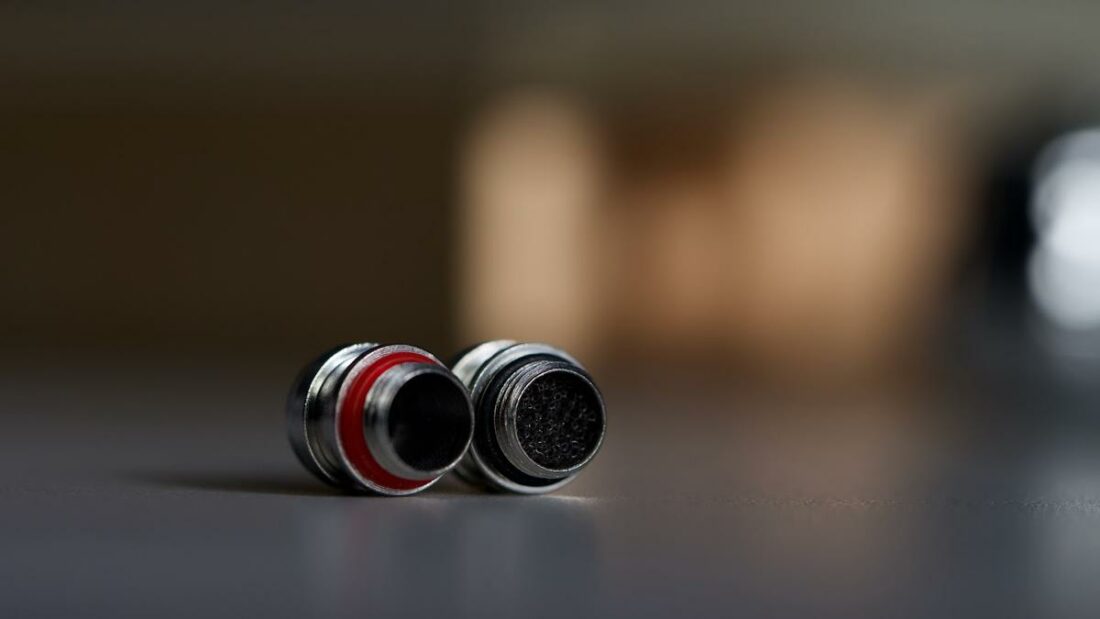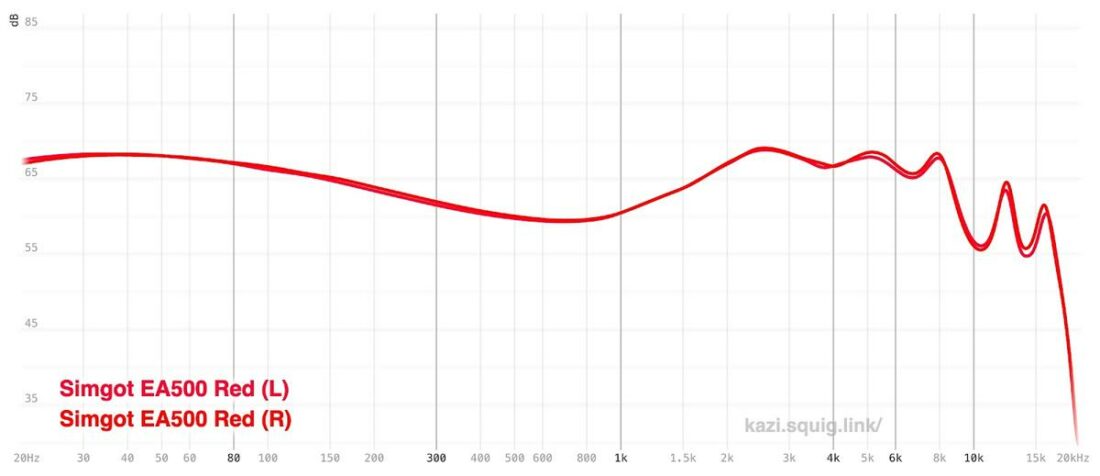Simgot’s entry-level IEMs aim to turn the market upside down by offering trickle-down technologies from higher-priced models.
Simgot is refreshing its IEM portfolio, and the first in line was the EN1000 I reviewed recently. The EA500 are a budget alternative and retain the single dynamic driver configuration.
- Excellent build and industrial design
- Comfortable fit despite the heavy shells
- Good stock cable
- Tuning filters can be fun to experiment with
- Dense bass response with good macrodynamic punch
- Inoffensive, engaging tuning
- Scratch-prone shells
- Stock tips are not the best
- Grainy, uneven treble
- Vocals lack articulation
- Microdynamics are not so evident
Of course, certain concessions have to be considered to lower the price, so the driver material, housing design, and accessories are less premium on the EA500. Then again, the sound is the most crucial factor, so if the EA500 deliver on that front, a lot can be overlooked.
Read on.
Technical Specifications
- Form: IEM
- Drivers: 1 x 10mm DLC composite dynamic driver
- Impedance (Ohm): 16 ohms
- Sensitivity (dB): 123 dB/Vrms
- Frequency Response (Hz): 10 Hz – 50 kHz
- Removable Cable: Y
- Source Jack: 3.5mm
- Cup/Shell Jack: 0.78mm
Packaging
The EA500 packaging is a welcome departure from the anime-themed motifs that have infested the market lately. Simgot shifts its focus to celebrating science instead, embodied in the tagline “Salute to Art and Science.”

Also, I never expected to see a Blaise Pascal quote on an IEM packaging – a nice surprise.

In the box
- Simgot EA500 IEMs
- 3 pairs of silicone tips
- Black tuning filters
- Carrying case
- 4-core SPC cable with 2-pin connectors and 3.5mm plug
- Spare O-rings
The stock cable is very good, apart from the somewhat aggressive angle of the memory hook.

The stock carrying case is serviceable. It has a mesh pocket inside to store the filters and spare washers.

Unfortunately, the stock tips are useless for me. They do not have enough “grip” to form a good seal, so I prefer third-party tips.

Design
Simgot EA500 have a design that belies their reasonable price tag.
They have a solid aluminum alloy build with a two-part shell design held together by screws. The faceplate logo has an iridescent shine under certain lighting conditions. I find such subtlety alluring.
One unfortunate aspect I noticed right out of the gate was the number of scratches that “adorned” the faceplate. Mirror finishes are prone to such imperfections, so there is that.

There is a vent near the nozzle and another close to the screw. The latter also controls airflow and can be taped over for several modifications.

The nozzle filters are screwed on – the red filter is on by default. The 2-pin connectors are slightly recessed into the housing. Please note that aftermarket cables with qdc connectors will not work with such recessed 2-pin ports.

The exceptional build quality is among the best under the USD$100 mark. The mirror finish requires some added care and maintenance, however.
Comfort and isolation
Isolation is merely average. General fit and comfort are good, but the heavier-than-average shells do not disappear when wearing.
Internals
The Simgot EA500 utilize a single, 10mm dynamic driver with a fourth-generation DLC-composite diaphragm. Such composite coatings usually end up stiffening the diaphragm further, enhancing transients.
The driver also sports a dual magnetic circuit design for a higher magnetic flux density.
Simgot EA500 Sound
The Simgot EA500 have a somewhat V-shaped sound signature.
The tuning nozzles can be swapped to enhance upper-midrange and lower-treble presence, but the lower-mids remain recessed in both configurations.
Tuning nozzles
The tuning nozzles are one of the highlights of the EA500.
The black filter has tuning foam inside, while the red filter is empty, so you can try different foam inserts to alter the signature. Filters from other products can also be used, e.g. Moondrop Kato.

The nozzles can be cumbersome to swap due to their small size, but it’s an effective method of modding IEMs without taking things apart.

The main differences between the red and black filter lie in the upper-midrange and lower-treble. Due to this extra emphasis around 2.5kHz and 5kHz, I find the black filter to have slightly more engaging mids.
Also, note the impeccable channel matching here. Even higher-end IEMs show more deviation at times, so kudos to Simgot for the QC.

Bass
The bass has good density and slam. In terms of speed, though, it sounds a bit sluggish.
Texture is good, but certain competing IEMs offer more texture at the expense of the “grunt” that the EA500 showcase. This is one of the trade-offs you must make in the budget range.
Midrange
Lower mids are recessed so that male vocals may lack articulation at times. Mids sound tonally correct, albeit there are hints of shoutiness in tracks that lack sub-bass.
Female vocals sound good but can get slightly subdued in clarity in bass-heavy tracks, especially with the red filter. Pianos have decent body in terms of note weight but could be denser in terms of the overall presentation.
Treble
Treble has some grain due to the unevenness in the response, and overall sparkle is somewhat subdued as a result. Cymbal hits lack precision and immediacy in heavier tracks.
Nothing offensive, just not very resolving or “crisp” in terms of attack. Upper-treble extension is also lacking, but it’s an issue with most single-dynamic driver IEMs.
Soundstage and imaging
Staging is better than average but falls short of class leaders. Imaging is competent regarding cardinal directions but could be improved when more subtlety comes into play.
Dynamics and speed
Overall macrodynamic punch is very good, but microdynamics could be more evident. Subtle shifts in volume are not as easily perceived as some competing offerings.
Comparisons
Vs Dunu Kima
The Dunu Kima retail for a similar price to the EA500 and also sport a single 10mm DLC dynamic driver.
In terms of build, both of these IEMs are stellar. Kima has a matte finish which can better withstand scratches.
Accessories are better on the Kima due to the excellent stock tips. Overall comfort is also better on the Dunu IEMs due to their lighter weight.

These IEMs are fairly similar in terms of overall bass response. It’s the mids and treble where some noticeable departures happen.
The Dunu Kima are warmer, denser in note weight, and even more relaxed in the treble region. Midrange also sounds more articulated in comparison. They do not show the grain or unevenness of the EA500 due to a more muted treble response.
The EA500 have a more exciting tuning, and the mid-treble clarity pushes details forward. The mids are less smooth sounding than on the Kima, though, and stage depth and imaging are also better on the Kima to my ears.
Overall, the Kima are better suited for more laid-back and relaxed listening. The EA500 are more resolving and can be more “fun” to listen to modern genres.
Where to Buy
Conclusion
The Simgot EA500 enter a heavily saturated market where it’s much easier to get lost than stand out. Fortunately, the EA500 have some neat tricks up their sleeve.
The tuning filters are simple but well-executed and offer meaningful changes in signature, which can be further tuned with foam inserts. The bass has good slam and a sense of rhythm, and the overall resolution is above average for the price tag.
However, it’s not all sunshine and rainbows. The grainy treble hints at the budget pricing, and the soundstage and imaging could be improved to match the class leaders.
Despite the issues, the EA500 are a competent offering. They may not be the mythical “market disruptor” that we all pine for, but they are capable and showcase enough merit in terms of overall tuning and design to stand out.

Hello, Thanks for the review. How’s this compared to another single DD IEM Like KATO and Oxygen?